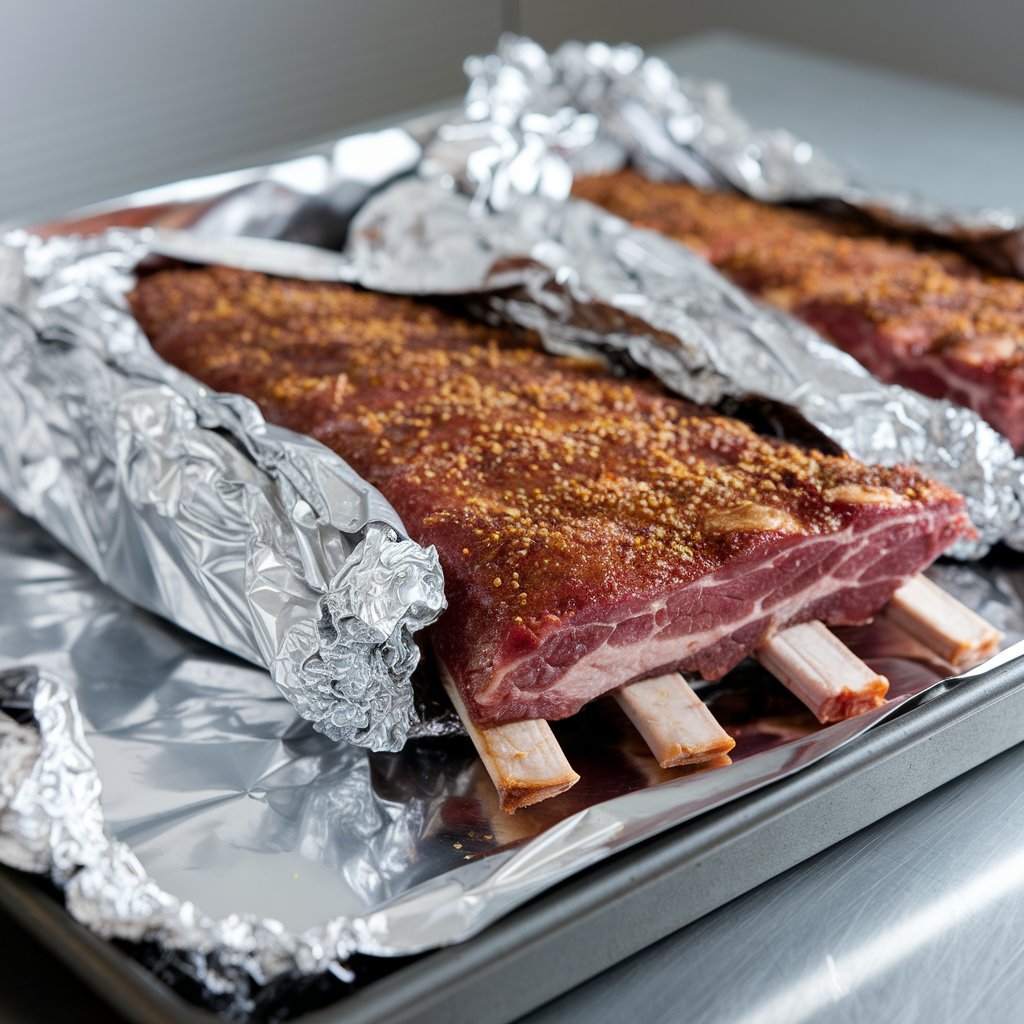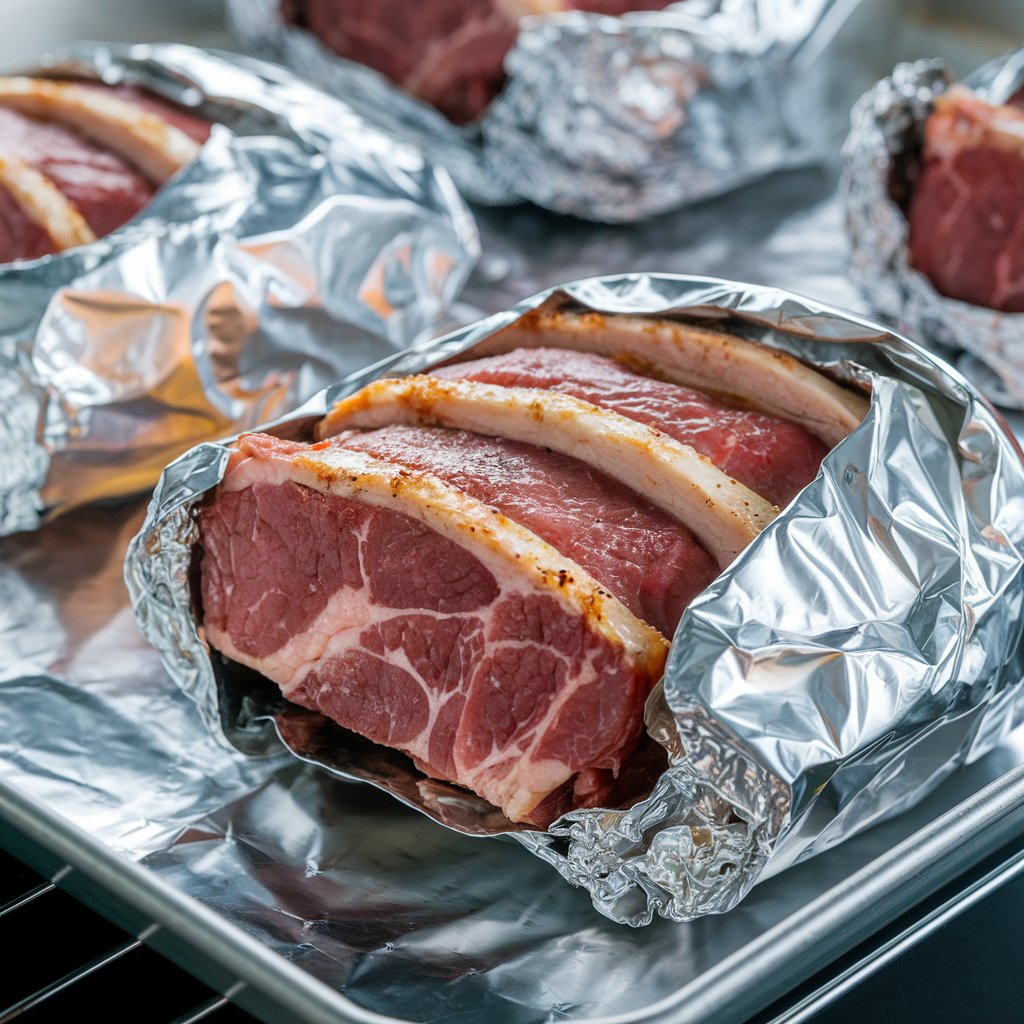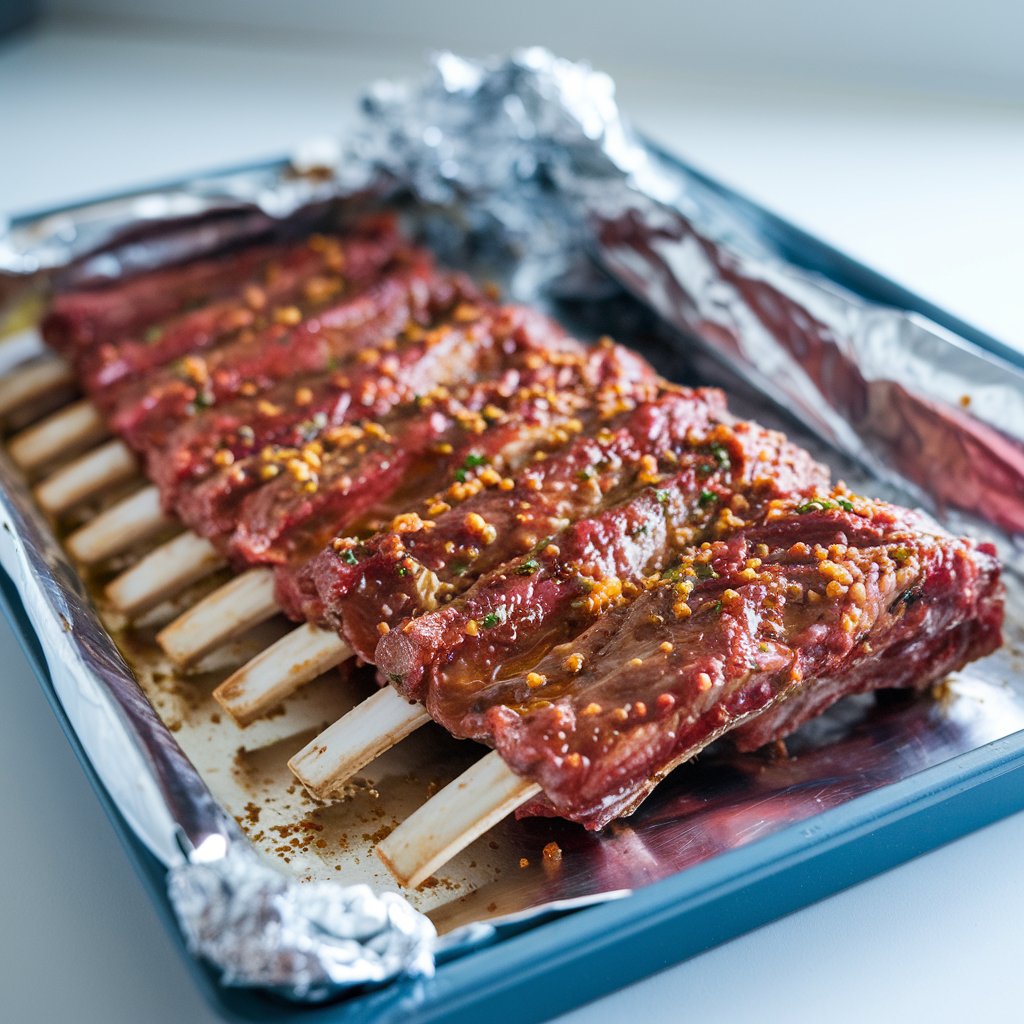Introduction
If you’re looking for a simple yet delicious way to cook beef ribs in the oven, this recipe is perfect. Oven-baking is a foolproof method that ensures tender, juicy ribs with minimal effort. Whether you’re hosting a gathering or craving a hearty dinner, these ribs are sure to be a hit.
Beef ribs in the oven—sounds simple, right? But let me tell you, there’s more to it than just tossing them in and hoping for the best. Whether you’re aiming for tender, juicy ribs that fall off the bone or flavorful bites that leave you licking your fingers, this guide has got you covered. 👨🍳
Cooking beef ribs in the oven is a skill that every home chef should master. Why? Because it’s one of the easiest ways to make restaurant-quality ribs without needing fancy equipment. Plus, your oven can turn a tough cut of meat into melt-in-your-mouth perfection with the right techniques. Stick with me here—I’ll show you everything from prepping to plating.
Ribs can be tricky, though. Overcooked ribs become dry, and undercooked ones can feel rubbery. But with a bit of patience and some tried-and-true tricks, you’ll avoid those pitfalls. Ready to dive in? Let’s start with the basics of why you should even consider cooking ribs in the oven in the first place.
Table of contents
Why Cook Beef Ribs in the Oven?
Not everyone has access to a smoker or grill year-round. That’s where the trusty oven comes in. Cooking beef ribs in the oven allows for precision control over temperature and cooking time, making it a foolproof method even for beginners.
The Advantages of Oven-Cooked Beef Ribs
Let’s talk pros. The oven offers consistent heat, which is essential for slow-cooking ribs. Unlike a grill, where hotspots can burn your meat, the oven provides even cooking from all angles. Plus, you don’t have to babysit the ribs constantly—just set it, check in occasionally, and let the magic happen. 🎉
When to Choose Oven Cooking Over Grilling
Grilling ribs is fantastic for smoky flavors, but it’s not always practical. Rainy days, cold weather, or lack of outdoor space can make grilling a challenge. In contrast, the oven is your year-round rib-cooking champion. Want tender ribs with a caramelized crust? The oven delivers every time.
Types of Beef Ribs
Before diving into the recipe, you’ve got to know your beef ribs. Not all ribs are created equal, and understanding the differences can make or break your cooking experience.
Short Ribs vs. Back Ribs: What’s the Difference?
Short ribs come from the lower part of the cow’s ribcage and have a higher fat content, making them incredibly flavorful. Back ribs, on the other hand, are leaner and cut from the top of the ribcage. Both can be cooked in the oven, but short ribs tend to be more forgiving for beginners.
Best Cuts for Oven Cooking
If you’re standing at the butcher’s counter, ask for “plate short ribs” or “dino ribs.” These are thicker and meatier, making them perfect for the slow-cooking method we’ll discuss later. Avoid thin cuts, as they can dry out easily.
Preparing Beef Ribs for the Oven + Cooking Techniques

Preparing Beef Ribs for the Oven
Before you even turn on the oven, there’s some prep work to be done. Trust me, taking a little extra time here makes all the difference between ribs that are “meh” and ribs that make you feel like a pro pitmaster. 🥩
Step-by-Step Trimming and Seasoning Guide
Step 1: Trim the Membrane
Most beef ribs come with a thin membrane on the bone side. This membrane can make the ribs tough and chewy, so it’s worth removing. Use a butter knife to slide under the membrane and a paper towel to grip and pull it off. It might take a couple of tries, but once it’s gone, your ribs will cook and taste so much better.
Step 2: Pat Dry
Moisture is the enemy of a good crust. Use paper towels to pat the ribs dry thoroughly.
Step 3: Season Generously
This is where the magic begins. Start with a simple seasoning mix of salt, black pepper, and garlic powder. Want to elevate the flavors? Try a rub with smoked paprika, chili powder, and a touch of brown sugar for that irresistible caramelized crust.
Pro Tip: Let the seasoning sit on the ribs for at least 30 minutes, or even overnight if possible. This dry-brining step helps the flavors penetrate deeper into the meat. 🌟
The Role of Marinades and Rubs
Marinades and dry rubs are your flavor powerhouses. Marinades, which are liquid-based, are great for tenderizing ribs and infusing them with herbs, spices, and acid (think vinegar or citrus juice). However, if you want a smoky, crusty exterior, stick to dry rubs. They create a flavorful bark during cooking that’s hard to beat.
How to Cook Beef Ribs in the Oven
Now that your ribs are prepped and seasoned, it’s time to cook. Oven-cooking might seem simple, but there are a few techniques that can take your ribs to the next level.
Low and Slow: The Secret to Tender Ribs
Patience is key. Cooking beef ribs at a low temperature (around 275°F) ensures that the connective tissues break down slowly, resulting in tender, juicy meat that practically falls off the bone.
Here’s a simple timeline:
- Preheat your oven: Set it to 275°F (135°C).
- Prepare your baking tray: Use a rimmed baking sheet lined with foil. Place a wire rack on top to elevate the ribs, allowing for even cooking.
- Wrap it up: Cover the ribs tightly with aluminum foil to lock in moisture.
The Ideal Cooking Temperature and Time
Cooking Times Based on Rib Type
- Short Ribs: Bake for 3–4 hours.
- Back Ribs: Bake for 2.5–3 hours.
Internal temperature is critical for perfect ribs. For beef ribs, aim for an internal temp of 190°F–205°F. Use a meat thermometer to ensure accuracy.
“The best beef ribs are a labor of love. Give them time, and they’ll reward you with every tender, flavorful bite.” ❤️
- Make the Perfect Beef Back Ribs Recipe
- How to Cook Short Ribs
- Juicy Baked Beef Ribs: Easy Oven Recipe
- Beef Back Ribs Oven
Foil Wrapping Technique: A Game-Changer
Wrapping your ribs in foil during cooking—also called the Texas Crutch—is a tried-and-true method for juicy, flavorful ribs. The foil traps steam, tenderizing the meat while preventing it from drying out.
Here’s how to do it:
- After 2 hours of cooking, remove the ribs from the oven.
- Wrap them in foil, adding a splash of beef broth or apple juice inside for extra moisture.
- Return them to the oven and continue cooking for the remaining time.
Pro Tip: During the last 30 minutes, remove the foil to let the ribs develop that beautiful caramelized crust.
Common Problems When Cooking Beef Ribs in the Oven
Even seasoned cooks run into challenges when making beef ribs. But don’t worry, I’ve got solutions to the most common issues.
Why Are My Ribs Tough? Fixing Overcooking and Undercooking
Tough ribs are often a sign that they weren’t cooked long enough. Remember: low and slow is the golden rule. If your ribs are still tough after the recommended cooking time, pop them back in the oven for another 30–60 minutes at the same temperature.
Dry Ribs? Solutions for Moisture Retention
Dry ribs are usually a result of too much heat or not enough moisture during cooking. Wrapping your ribs in foil and using a basting liquid (like broth, barbecue sauce, or melted butter) can save the day. And always make sure your oven temperature isn’t too high.
Sauces, Serving Tips, and FAQ Section
Sauces and Glazes for Beef Ribs
No rib recipe is complete without a finger-licking sauce or glaze to tie all the flavors together. Whether you’re a fan of tangy, sweet, or spicy, there’s a sauce for you. 🍯🔥
Classic Barbecue Sauce Recipes
Barbecue sauce is the holy grail of rib condiments. You can either use store-bought for convenience or whip up your own. Here’s a quick and easy recipe for homemade barbecue sauce:
Ingredients:
- 1 cup ketchup
- 1/4 cup apple cider vinegar
- 1/4 cup brown sugar
- 1 tbsp Worcestershire sauce
- 1 tsp smoked paprika
- 1/2 tsp garlic powder
- A pinch of cayenne pepper (optional for heat)
Instructions:
- Combine all the ingredients in a saucepan.
- Simmer over medium heat for 10–15 minutes until it thickens.
- Brush generously onto your ribs during the last 15–20 minutes of cooking.
“Homemade barbecue sauce is like the cherry on top—sweet, smoky, and utterly irresistible.” 🍒
Experimenting with Sweet and Spicy Glazes
If you’re feeling adventurous, try adding a glaze during the last 10 minutes of cooking. Here are two options:
Sweet Glaze:
Combine honey, a splash of orange juice, and a pinch of cinnamon for a sticky-sweet finish.
Spicy Glaze:
Mix sriracha, soy sauce, and brown sugar for a fiery, savory kick.
Remember, balance is key. Sweet and spicy flavors should complement the richness of the beef ribs, not overpower them.

Tips for Serving Oven-Cooked Beef Ribs
Once your ribs are cooked to perfection, it’s time to serve them up in style. Presentation and pairings matter just as much as the cooking.
Side Dishes That Complement Beef Ribs
Ribs are the star of the show, but a good supporting cast takes the meal to the next level. Here are a few sides that pair beautifully with oven-cooked beef ribs:
- Creamy Coleslaw: The crunch and tanginess of coleslaw balance the richness of the ribs.
- Cornbread: Slightly sweet and fluffy, cornbread is a classic rib companion.
- Baked Beans: Smoky and hearty, they round out a barbecue-inspired meal.
- Grilled Vegetables: Charred zucchini, bell peppers, or asparagus add freshness to your plate.
Presentation Ideas for a Mouthwatering Meal
Presentation makes a difference! Arrange your ribs on a wooden board or a large platter, with sauce drizzled over the top and extra on the side for dipping. Garnish with chopped parsley or fresh thyme for a pop of color.
“Good food feeds the stomach; great food feeds the soul. Beef ribs are all about sharing moments with loved ones.” 💖
FAQ Section
Every great guide needs to answer common questions. Let’s tackle a few FAQs to make sure you’re ready to conquer any rib-related challenge.
How Long Should I Cook Beef Ribs in the Oven?
For best results, cook beef ribs at 275°F (135°C) for 3–4 hours, depending on the type of ribs. The meat should be tender and the internal temperature should reach 190°F–205°F for optimal results.
Can I Use Frozen Ribs?
Yes, but you’ll need to thaw them first. Cooking frozen ribs directly in the oven leads to uneven cooking. To thaw, leave them in the fridge overnight or use a cold water bath for faster results.
Should I Use a Meat Thermometer?
Absolutely! A meat thermometer ensures your ribs are cooked perfectly. Insert it into the thickest part of the meat (avoiding the bone) to get an accurate reading.
Do I Need to Rest the Ribs Before Serving?
Yes! Resting your ribs for 10–15 minutes after cooking allows the juices to redistribute, keeping the meat moist and flavorful.
Troubleshooting and Conclusion
Common Problems When Cooking Beef Ribs in the Oven
Cooking beef ribs might seem simple, but a few common hiccups can derail your rib feast. Let’s troubleshoot the most frequent issues and how to fix them. 🚨
Why Are My Ribs Tough? Fixing Overcooking and Undercooking
Tough ribs are the bane of rib lovers everywhere. The most common culprit? Not enough cooking time. Beef ribs need low, steady heat over several hours to break down the connective tissues and become tender.
If you’ve cooked them for hours and they’re still tough, your oven temperature might have been too high. Check that your oven thermometer reads 275°F (135°C)—the ideal temp for tender, juicy ribs.
Quick Fix: Cover your ribs with foil, add a splash of beef broth or apple juice, and return them to the oven at low heat for an additional 30–60 minutes. This extra step will tenderize the meat.
Dry Ribs? Solutions for Moisture Retention
No one wants dry ribs, and they’re a sign that too much moisture escaped during cooking. The key is in the preparation and cooking method..links.Tender Beef Short Ribs Baked
- Foil Wrapping: Traps steam and keeps the ribs juicy.
- Basting: Apply sauce or broth every hour during cooking to lock in moisture.
- Marinating: Overnight marinades not only infuse flavor but help keep the meat tender.
Pro Tip: Always rest your ribs after cooking. This simple step allows the juices to redistribute, making every bite moist and flavorful.
My Ribs Don’t Have a Crust!
That crispy, caramelized crust is one of the best parts of beef ribs. If your ribs lack that golden glaze, the problem might be not uncovering them at the right time.
Solution: During the last 30 minutes of cooking, remove the foil and crank up the oven to 400°F (200°C) or switch on the broiler for 5–10 minutes. Brush on barbecue sauce or a glaze to help the crust form faster.
Conclusion: Mastering Beef Ribs in the Oven
There you have it—everything you need to know to cook perfect beef ribs in the oven. From prepping the meat to troubleshooting the trickiest problems, you’re now equipped to impress your family, friends, or even just yourself with this hearty and flavorful dish.
Remember, the secret lies in patience. Low and slow cooking transforms a tough cut of beef into a melt-in-your-mouth masterpiece. Pair your ribs with delicious sides, experiment with sauces and glazes, and most importantly, have fun!
Whether it’s a cozy Sunday dinner or a celebration, beef ribs cooked in the oven are always a crowd-pleaser. So, roll up your sleeves, grab your favorite seasoning blend, and get ready to create ribs that rival any barbecue joint. 🍖
Title:
“Delicious Beef Ribs in the Oven: Easy and Tender Recipe”
links..Beef Short Ribs Recipe For Dinner
Meta Description:
“Learn how to cook beef ribs in the oven with this simple recipe. Perfectly seasoned, tender, and flavorful, these ribs are great for any occasion!”
Focus Keyphrase:
“Beef ribs in oven”

